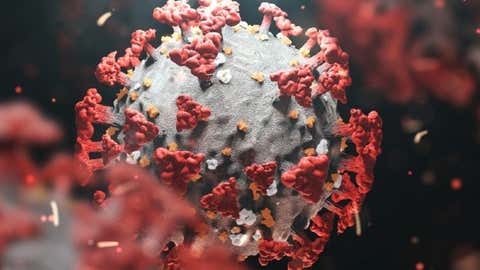Infection
Coronavirus’s Spike Proteins Have ‘Hinges’ That Can Be Targeted to Help Battle Infections!

Representational Image
(IANS)
Imagine this: a horrifying entity exuding malevolence, with spikes jutting out of its centre haphazardly. Its body tingles with expectation as it stealthily prowls in search of its next unsuspecting target. And when it finds one, it quickly digs in with its jagged spikes, injecting its venom inside the hapless prey. As the infection spreads through the recipient, the assailant becomes one with the victim, using its body to multiply inside it and spawn sinister replicas of its own.
We realise that the picture we may have inadvertently (maybe deliberately) painted is one of a Spiderman villain or some demonic creature from a mythical anime. However, this was simply a whimsical take on how the COVID-19-causing SARS‑CoV‑2 virus works.
How this teeny tiny virus, that’s not even visible even under a microscope, managed to cause a history-altering pandemic is something that has long intrigued scientists. And now, even after the dust has settled for the most part, researchers continue studying this virus. You know, to create better vaccines just in case it decides to make a full-fledged comeback or if others like it show up in the future.
Recently, scientists got a better, high-res look at a slightly less dangerous relative of the COVID-19-causing coronavirus’s spike proteins, which play a pivotal role in the virus’s ability to attach to and invade host cells and are also added in many vaccines. And what they saw was something that may hold significant implications for combating a wide range of coronavirus infections, including COVID-19.
Turns out, contrary to their name, the spikes of a coronavirus aren’t rigid or pointed; rather, they resemble chicken drumsticks, their meaty parts facing outwards and titling on their slender stalks. This flexibility and tilting capability directly impact the spike’s efficacy in infecting cells.
Scientists found a minuscule hinge encircled by sugar molecules, allowing the crown-like structure of the spike to flex on its stalk. Alterations to this hinge structure demonstrated a substantial impact on the spike’s infectivity, suggesting a potential target for combating the virus.
Another noteworthy discovery was that each coronavirus particle exhibits uniqueness in its overall shape and spike display. Some particles are spherical, while others possess different spike densities, varying from fully adorned to nearly bare. Up close, each spike displayed individuality in its movement and orientation, notably in its direction and degree of tilting.
However, the team’s focus on this hinge region, which is highly conserved among coronaviruses, suggests a promising avenue for developing universal therapies or vaccines. Discovering these spike hinges offer a glimmer of hope in the ongoing battle against COVID-19 and other coronavirus infections.
The study’s breakthrough findings were made possible by imaging the spikes of a less severe coronavirus strain while they remained attached to the virus particles, enabling the first-ever observation of coronavirus spikes in this context.
Despite challenges in imaging both the crown and stalk of the spike simultaneously due to the latter’s thinness, a combination of experiments ultimately provided a comprehensive view. Cryogenic electron tomography, computational analysis, advanced imaging techniques, mass spectrometry, and simulations converged to reveal the precise molecular composition, flexibility, and bending capability of the spikes.
Findings of this study have been detailed in Nature Communications and can be accessed here.
**
For weather, science, space, and COVID-19 updates on the go, download The Weather Channel App (on Android and iOS store). It’s free!

